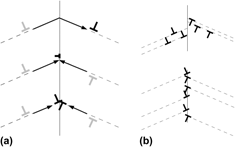Crossref Citations
This article has been cited by the following publications. This list is generated based on data provided by
Crossref.
Bayerschen, E.
Stricker, M.
Wulfinghoff, S.
Weygand, D.
and
Böhlke, T.
2015.
Equivalent plastic strain gradient plasticity with grain boundary hardening and comparison to discrete dislocation dynamics.
Proceedings of the Royal Society A: Mathematical, Physical and Engineering Sciences,
Vol. 471,
Issue. 2184,
p.
20150388.
Zhang, X.
Romanov, A. E.
and
Aifantis, E. C.
2015.
A Simple Physically Based Phenomenological Model for the Strengthening/Softening Behavior of Nanotwinned Copper.
Journal of Applied Mechanics,
Vol. 82,
Issue. 12,
Zhao, Jianfeng
Zhang, Xu
Konstantinidis, Avraam A.
and
Kang, Guozheng
2015.
Correlating the internal length in strain gradient plasticity theory with the microstructure of material.
Philosophical Magazine Letters,
Vol. 95,
Issue. 6,
p.
340.
Stricker, Markus
and
Weygand, Daniel
2015.
Dislocation multiplication mechanisms – Glissile junctions and their role on the plastic deformation at the microscale.
Acta Materialia,
Vol. 99,
Issue. ,
p.
130.
Zhang, X.
and
Aifantis, K.E.
2015.
Examining the evolution of the internal length as a function of plastic strain.
Materials Science and Engineering: A,
Vol. 631,
Issue. ,
p.
27.
Isaksson, P.
2015.
A note on stress fields and crack growth in porous materials subjected to a contact load.
International Journal of Solids and Structures,
Vol. 64-65,
Issue. ,
p.
62.
Stricker, M.
Gagel, J.
Schmitt, S.
Schulz, K.
Weygand, D.
and
Gumbsch, P.
2016.
On slip transmission and grain boundary yielding.
Meccanica,
Vol. 51,
Issue. 2,
p.
271.
Bayerschen, E.
McBride, A. T.
Reddy, B. D.
and
Böhlke, T.
2016.
Review on slip transmission criteria in experiments and crystal plasticity models.
Journal of Materials Science,
Vol. 51,
Issue. 5,
p.
2243.
Bayerschen, E.
Prahs, A.
Wulfinghoff, S.
Ziemann, M.
Gruber, P. A.
Walter, M.
and
Böhlke, T.
2016.
Modeling contrary size effects of tensile- and torsion-loaded oligocrystalline gold microwires.
Journal of Materials Science,
Vol. 51,
Issue. 16,
p.
7451.
Armstrong, R.W.
2016.
Reference Module in Materials Science and Materials Engineering.
Basak, Anup
and
Gupta, Anurag
2017.
Influence of a mobile incoherent interface on the strain-gradient plasticity of a thin slab.
International Journal of Solids and Structures,
Vol. 108,
Issue. ,
p.
126.
Yue, Y. M.
Xu, K. Y.
Tan, Z. Q.
Wang, W. J.
and
Wang, D.
2019.
The influence of surface stress and surface-induced internal residual stresses on the size-dependent behaviors of Kirchhoff microplate.
Archive of Applied Mechanics,
Vol. 89,
Issue. 7,
p.
1301.
Lu, Songjiang
Zhang, Bo
Li, Xiangyu
Zhao, Junwen
Zaiser, Michael
Fan, Haidong
and
Zhang, Xu
2019.
Grain boundary effect on nanoindentation: A multiscale discrete dislocation dynamics model.
Journal of the Mechanics and Physics of Solids,
Vol. 126,
Issue. ,
p.
117.
Aifantis, K. E.
Deng, H.
Shibata, H.
Tsurekawa, S.
Lejček, P.
and
Hackney, S. A.
2019.
Interpreting slip transmission through mechanically induced interface energies: a Fe–3%Si case study.
Journal of Materials Science,
Vol. 54,
Issue. 2,
p.
1831.
Jiang, Maoyuan
Devincre, Benoit
and
Monnet, Ghiath
2019.
Effects of the grain size and shape on the flow stress: A dislocation dynamics study.
International Journal of Plasticity,
Vol. 113,
Issue. ,
p.
111.
Zhang, Xu
Xiong, Jian
Fan, Haidong
and
Zaiser, Michael
2019.
Microplasticity and yielding in crystals with heterogeneous dislocation distribution.
Modelling and Simulation in Materials Science and Engineering,
Vol. 27,
Issue. 7,
p.
074003.
Wei, DeAn
Zaiser, Michael
Feng, Zhiqiang
Kang, Guozheng
Fan, Haidong
and
Zhang, Xu
2019.
Effects of twin boundary orientation on plasticity of bicrystalline copper micropillars: A discrete dislocation dynamics simulation study.
Acta Materialia,
Vol. 176,
Issue. ,
p.
289.
Lu, Songjiang
Xiong, Jian
Wei, Dean
Ding, Yifan
Zhang, Bo
Wu, Ronghai
and
Zhang, Xu
2020.
Effect of Dislocation Mechanism on Elastoplastic Behavior of Crystals with Heterogeneous Dislocation Distribution.
Acta Mechanica Solida Sinica,
Vol. 33,
Issue. 4,
p.
487.
Shuang, Fei
and
Aifantis, Katerina E.
2020.
Using molecular dynamics to determine mechanical grain boundary energies and capture their dependence on residual Burgers vector, segregation and grain size.
Acta Materialia,
Vol. 195,
Issue. ,
p.
358.
Jiang, Maoyuan
Monnet, Ghiath
and
Devincre, Benoit
2021.
On the origin of the Hall–Petch law: A 3D-dislocation dynamics simulation investigation.
Acta Materialia,
Vol. 209,
Issue. ,
p.
116783.





